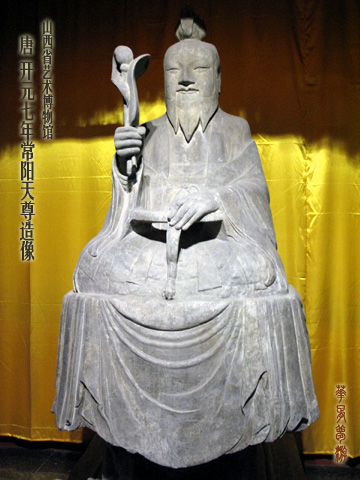Changyang Tianzun Statue: Taoism Flourished in Tang Dynasty
Name: Changyang Tianzun Statue | 中文名: 常阳天尊像(太尊石像)
Dated to: 719 A.D. | Culture: Tang Dynasty, Kaiyuan Era
Made at: Anyi, Yuncheng, Shanxi | Now at: Shanxi Art Museum

Changyang Tianzun Statue | {link:http://blog.sina.com.cn/s/blog_4bce418d010095ph.html}华胥梦游{/link}
In Tang Dynasty, the royal family worshiped Taoism. Laozi was crowned as the ancestor of royal family and a major god. Taoist temples were built across the country. Therefore, Taoist statue gained great development during the time.
At that time, Taoist statue had gradually formed its own unique style. The statues from Tang Dynasty have rich and full character figures, mostly used round curves, and smooth freely extended clothes drapery. Changyang Tianzun Statue is one of the rare Tang Dynasty statue examples we have today.
This statue is about 1.5m tall, made with white rock. It has a rich figure and harmony expression. It holds a fan on right hand while leaning on the table by left hand. It sits on a rectangular stone base. On the four sides of the base, there are some religious inscriptions and the names of donors. Overall, this statue is a beautiful presentation with skillful techniques.
Changyang Tianzun Statue is now at Shanxi Art Museum — Pure Yang Palace (Chun-Yang Gong).
At the north corner of modern May Day Square in the city of Taiyuan, there is an ancient palace complex with red wall and green roof tiles — that’s where Shanxi Art Museum locates: a Taoist temple “Pure Yang Palace (纯阳宫)”.
Pure Yang Palace aka. Temple of Dongbin Lu, was originally a Taoist temple that worshiped famous Taoist master Dong-Bing Lu. For he is called Master Pure-Yang (ChunYang Zi), so this temple was named Pure Yang Palace (Chun-Yang Gong).
Pure Yang Palace was founded in late Song Dynasty as a small temple. In Wanli Era of Ming Dynasty, it was renovated, and many lofts, pagodas, pavilions were built in the palace, which perfectly integrated garden landscape with Taoist temple architecture art. In Jiaqing Era of Qing Dynasty, a new tall three-floor building was added to top of the kiln in the backyard. Since then, Pure Yang Palace had become a main attraction in the City of Taiyuan.
Pure Yang Palace is not only a pearl of art of unique value in Chinese traditional architecture, but also now home (as Shanxi Art Museum) to an enormous amount of cultural relics found in Shanxi across entire history of China.
[Forbidden Treasure of China Series]
This is the 25th of 64 culture heritages that the government of China forbids to exhibit abroad. The complete list is here. In Chinese.
[Chinese Keywords]
国家一级文物 禁止出境




